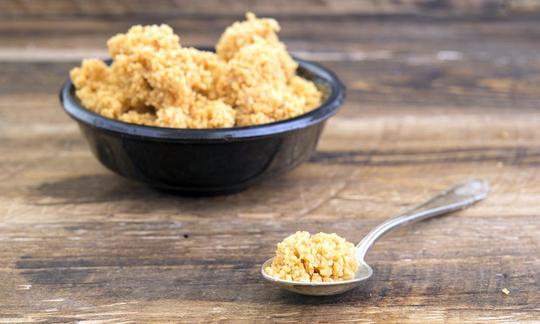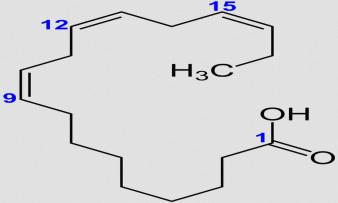Table of contents
In the kitchen , powdered lecithin from soybeans is basically used to make emulsions of oil and water or air and water.
Use in the kitchen
What is lecithin? Lecithin is a phosphorus-containing, fat-like substance and enables the mixing of two substances that would otherwise be immiscible, for example oil and water or air and water. Emulsifiers are contained in many industrially produced foods, for example in poorer quality chocolate, couverture, margarine, ready-made baked goods and ready-made soups. The most common is lecithin from soybeans, which has a characteristic bean-like to neutral smell and taste.
How should you dissolve lecithin granules or lecithin powder? Lecithin from soybeans can be easily dissolved in cold water or liquid.
In the kitchen, vegan lecithin made from soybeans is used as a binding agent, which enables the bond between fat and water, as well as water and air. For example, it is needed to make vegan mayonnaise or vegan ice cream. By adding lecithin, vegan sauces are easier to foam up. It is also easier to whip up mousses or make light creams with the addition of lecithin. Lecithin is also popular for making airy foams, such as almond foam. Thanks to the addition of lecithin, this is nice and firm and much longer lasting than without. Such foams can be made from various juices, for example orange juice, apple juice, carrot juice, lime juice or lemon juice. To do this, you mix the juice with the added lecithin from top to bottom with a hand mixer to add as much air as possible. When baking bread and baked goods, lecithins ensure better volume, finer pores, crispier crusts and longer-lasting freshness. They also improve the baking results of low-gluten or gluten-free doughs.
Vegan recipe for foamable oat drink with soy lecithin
Ingredients (for 1 liter of oat drink): 120 g whole grain oat flakes, 1 l drinking water, 1 tbsp nut butter ( cashew, almond or macadamia butter), 1 tsp soy lecithin. As well as a fine-mesh sieve, strainer or nut milk bag, and a powerful blender.
Preparation: Soak the oat flakes in enough water for 3 to 12 hours. If you have a powerful blender, you can skip this step. Either sieve the soaked oat flakes and put them in the blender with fresh water, or use the soaking water directly. Only add some of the water to start with. Then chop the flakes well in the blender and gradually add more water. Filter the oat flakes-water mixture through a fine sieve or nut milk bag. Mix the oat drink with the nut butter and lecithin and mix thoroughly again with the blender. The finished foamable oat drink can be kept in the fridge for a few days. If necessary, it can be quickly foamed again.
Vegan recipes with soy lecithin can be found under the note: " Recipes that have the most of this ingredient ".
| Not only vegans or vegetarians should read this: Vegans often eat unhealthily. Avoidable nutritional errors. |
Purchasing - Storage
Lecithin powder from soybeans is available online, and can also be found in health food stores, organic supermarkets such as Denn's Biomarkt or Alnatura, as well as drugstores and pharmacies, where it is also usually organic. Soy lecithin is rarely found in the range of large supermarket chains such as Coop, Migros, Denner, Volg, Spar, Aldi, Lidl, Billa, Rewe, Edeka or Hofer. Lecithin is sometimes sold as a dietary supplement in capsule or powder form.
The availability of soya lecithin in the supermarkets mentioned varies depending on the size of the store, catchment area, etc. If you are interested, click on our recorded food prices for the DA-CH countries (above under the ingredient image). There you will find current prices from various supermarkets and their price development.
Storage tips
Soya lecithin can be bought in powder or granulate form. Stored in the original packaging in a cool, dry place, the lecithin should be used up by the best-before date.
Ingredients - Nutritional values - Calories
Soya lecithin (organic) contains 884 kcal per 100 g and consists of 100% fat. It contains no carbohydrates, fiber or proteins. 1
Unsaturated fatty acids: The ratio of omega-6 to omega-3 fatty acids in soy lecithin is 7:1 (see ingredient tables and link in the box above). This means that there is more pro-inflammatory LA (omega-6) and less anti-inflammatory omega-3 in the form of ALA. According to the Federal Office of Public Health ( FOPH), the value should not exceed 5:1 (LA:ALA) on average. Erb muesli, for example, can correct this. In contrast, linseeds have an extremely healthy ratio of 1:4 (see ingredient tables and link in the box above). If you enter the option "sorting by health values" in the ingredient list, you can select healthy ingredients or those that compensate for a deficiency. The same applies to the recipes, e.g. with sorting by LA:ALA ratio. You can see the importance of this aspect in the link to olive oil, where we explain it in detail. 1
The complete ingredients of soy lecithin, the coverage of the daily requirement and comparison values with other ingredients can be found in our nutrient tables. In the article Nutrients explained you will get a detailed insight into the topic.
Health effects
Is lecithin good for the brain? Lecithin is an important nutrient for the brain and nervous system. Lecithin, or the choline it contains, belongs to the group of phospholipids, which are important components of cell membranes, including in the brain and nerve cells. Lecithin is also the starting substance for important neurotransmitters in the brain and nervous system, such as acetylcholine. 6,7
As a dietary supplement, lecithin is available in pharmacies and drugstores in the form of capsules, granules and as a pure substance (powder or liquid). It is used to replace choline and as a general tonic for reduced mental and physical performance. 3 The daily requirement of choline recommended by the EFSA is 400 mg for adults (as of 2016). 11 Although lecithin, choline and acetylcholine are essential for the brain and nerve cells, there is no recommendation for supplementation based on current knowledge, as the body's own synthesis of choline appears to be sufficient. 6
Whether an additional administration of lecithin in the form of a dietary supplement can have a positive effect on cognitive function, the function of the nervous system or concentration is the subject of current research. Studies on mice and rats show that a high consumption of choline during pregnancy and the postnatal period led to an improvement in cognitive function and, among other things, protected the brain from neuropathological changes associated with Alzheimer's disease (AD). 10
Individual studies have demonstrated a therapeutic effect on mild to moderate Alzheimer's disease in humans. Patients received a supplement of 400 mg of choline alfoscerate (alpha-GPC) three times a day for 180 days. In contrast to the control group, which received a placebo, all evaluated parameters improved compared to baseline values, while they remained unchanged or worsened in the placebo group. The results of this study indicate the clinical benefit and tolerability of choline alfoscerate in the treatment of the cognitive symptoms of Alzheimer's type dementia. 12
However, there are also numerous studies that found no connection between the consumption of choline and the maintenance of normal neurological and cognitive function, which is why the European Food Safety Authority (EFSA) rejected the 'health claim' of soy phosphatidylcholine and choline and products containing these substances are not allowed to advertise with this 'health claim'. 8,9
Dangers - Intolerances - Side effects
Lecithin often consists of soy, which is one of the 14 main allergens. 2 People with a soy allergy should therefore avoid consuming lecithin from soybeans. People who are allergic to flower pollen must also be careful, as cross-allergies can occur. 3
Ecological footprint - animal welfare
The ecological footprint and water consumption of soy lecithin is made up of the main ingredient (soybeans), the individual production steps, packaging and transport, and varies greatly. Soy has fallen into disrepute in recent years due to large-scale deforestation of rainforests in South America for monocultures. 16 In tropical climates, this plant is also very susceptible to pests, which is why herbicides are used extensively in these countries. 17 However, it should be remembered that 76% of the global soy harvest ends up as animal feed in milk and meat production (2017-2019) and only 20% of soybeans and the products made from them are used directly by humans. 18 Rainforests do not have to be cleared for this, because soybeans are also grown in Europe, often in organic farming that does not use pesticides or herbicides. Accordingly, when purchasing it, it is best to choose regional soy lecithin of organic quality.
The production of soya lecithin requires many individual steps (see Industrial Production), some of which are very energy-intensive. A more energy-efficient alternative would be sunflower lecithin, which is obtained through a cold-pressing process. No chemical solvents are used in this process either. 19
Worldwide occurrence - cultivation
Soybeans, from which vegan lecithin is obtained, originally come from China. Thanks to the wide range of processing and application options, the soybean is one of the most important commercial crops grown worldwide (you can find out more under the link to soybeans).
In the EU, lecithins are approved as additives and are listed as lecithin, soya lecithin or E 322. E 322 is used as an antioxidant, emulsifier or stabilizer. The food additive E322 includes lecithins of different origins. These are produced from soya, rapeseed, sunflowers and, in the past, chicken eggs. 5
Industrial production
Soy lecithin is an industrially manufactured product that is no longer very close to its natural state. To produce lecithin, the soybeans are peeled in a roller before being heated in an oven to 60 to 88°C. They are then crushed into flakes and allowed to cool to at least 69°C before the flakes are mixed with hexane to extract the lecithin. The mixture is separated by reheating and filtering so that the soy lecithin separates from the hexane. 13,14
Soy lecithin can also be made from soy oil. To do this, the soy oil is diluted a little with water (2-3% of the volume of the oil) and the mixture is heated to 50 to 70 °C. The lecithins hydrate and a lecithin paste is formed, which is separated from the rest of the soy oil by centrifugation. The lecithin paste is then heated so that the water it contains evaporates. The lecithin is cooled to 20 to 30 °C to prevent discoloration. After drying, soy lecithin can be stored at room temperature for months. 14 Hydrogen peroxide is sometimes used to bleach the reddish-brown soy lecithin. 13,14 If the lecithin is to be in the form of granules, the remaining soy oil is extracted using acetone. 13
Organic lecithin is made from organically grown soybeans without genetically modified seeds. The extraction is usually carried out without solvents, but with the help of steam.
Further information
The term lecithin (Greek λέκιθος lekithos, German 'egg yolk') refers to a group of chemical compounds called phosphatidylcholines. These are phospholipids that consist of fatty acids, glycerin, phosphoric acid and choline and are contained in the cell membranes of animal and plant organisms.
Deoiled lecithins from soybeans are powdered or granulated and, when well purified (refined), have a characteristic, bean-like to neutral smell and taste. Lecithins from soybeans are soluble in oils and fats.
Alternative names
An alternative spelling for lecithin is lecithin.
Other applications
Lecithin is used in addition to the food industry in the manufacture of cosmetics and pharmaceuticals, as well as in coatings (paints, waxes, polishes) and various production sectors such as the plastics and rubber industry, glass and ceramics processing, asphalt products, the petroleum industry, and metal processing. 13
Bibliography - 17 Sources (Link to the evidence)
| 1. | USDA United States Department of Agriculture. |
| 2. | Medizinische Universität Wien. Die 14 wichtigsten Allergene. |
| 3. | Bundesinstitut für Risikobewertung. Birkenpollenallergiker können auf Sojaprodukte besonders empfindlich reagieren. 2007. |
| 5. | Zusatzstoffmuseum.de. E 322 Lecithine. |
| 6. | Biesalski H K, Grimm P. Taschenatlas der Ernährung. Stuttgart: Georg Thieme Verlag; 2015, 6. Auflage. |
| 7. | Śliwińska S, Jeziorek M. The role of nutrition in Alzheimer's disease. Rocz Panstw Zakl Hig. 2021;72(1): 29-39. |
| 8. | European Food Safety Authority. Scientific Opinion on the substantiation of health claims related to choline EFSA Journal 2011;9(4): 2056. |
| 9. | European Food Safety Authority. Scientific Opinion on the substantiation of health claims related to soy phosphatidyl choline. EFSA Journal 2001;8(10): 1741. |
| 10. | Blusztajn JK, Slack BE, Mellott TJ. Neuroprotective Actions of Dietary Choline. Nutrients. 2017 Jul 28;9(8): 815. |
| 11. | European Food Safety Authority Dietary reference values for choline. EFSA Journal 2016;14(8): e04484. |
| 12. | De Jesus Moreno Moreno M. Cognitive improvement in mild to moderate Alzheimer's dementia after treatment with the acetylcholine precursor choline alfoscerate: a multicenter, double-blind, randomized, placebo-controlled trial. Clin Ther. 2003 Jan;25(1): 178-93. |
| 13. | Soyinfocenter.com. History of Soy Lecithin. |
| 14. | Nationallecithin.com. How is Soy Lecithin made? |
| 16. | WWF Schweiz. Der Sojaboom - Auswirkungen und Lösungswege. 2014. |
| 17. | Bundesinformationszentrum Landwirtschaft. Soja - Nahrungsmittel für Tier und Mensch. |
| 18. | Our Wold in Data. Soy. 2021. |
| 19. | Lecitein. Soy Lecithin vs Sunflower Lecithin: What Makes Them Different? 2023. |








Comments